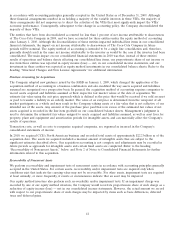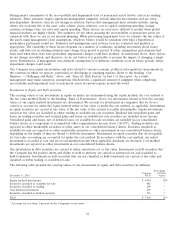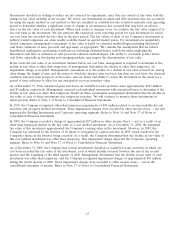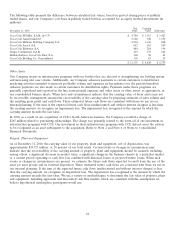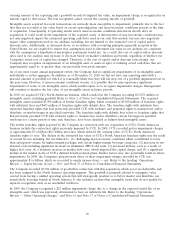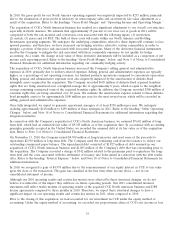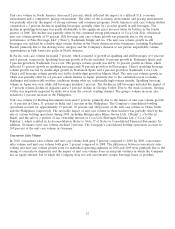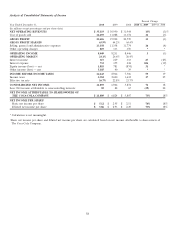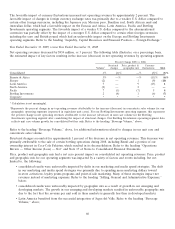Coca Cola 2010 Annual Report Download - page 53
Download and view the complete annual report
Please find page 53 of the 2010 Coca Cola annual report below. You can navigate through the pages in the report by either clicking on the pages listed below, or by using the keyword search tool below to find specific information within the annual report.sales volume when we sell concentrate to the authorized unconsolidated bottling and canning operations and we
typically report unit case volume when finished products manufactured from the concentrates and syrups are sold to the
customer. When we analyze our net operating revenues we generally consider the following four factors: (1) volume
growth (unit case volume or concentrate sales volume, as appropriate), (2) structural changes, (3) changes in price,
product and geographic mix and (4) foreign currency fluctuations. Refer to the heading ‘‘Net Operating Revenues,’’
below.
‘‘Structural changes’’ generally refers to acquisitions or dispositions of bottling, distribution or canning operations and
consolidation or deconsolidation of bottling and distribution entities for accounting purposes. Typically, structural
changes do not impact the Company’s unit case volume on a consolidated basis or at the geographic operating segment
level. We recognize unit case volume for all sales of Company beverage products regardless of our ownership interest in
the bottling partner, if any. However, our Bottling Investments operating segment is generally impacted by structural
changes because it only includes the unit case volume of consolidated bottlers.
The Company sells concentrates and syrups to both consolidated and unconsolidated bottling partners. The ownership
structure of our bottling partners impacts the timing of recognizing concentrate revenue and concentrate sales volume.
When we sell concentrates or syrups to our consolidated bottling partners, we are not able to recognize the concentrate
revenue or concentrate sales volume until the bottling partner has sold finished products manufactured from the
concentrates or syrups to a customer. When we sell concentrates or syrups to our unconsolidated bottling partners, we
recognize the concentrate revenue and concentrate sales volume when the concentrates or syrups are sold to the
bottling partner. The subsequent sale of the finished products manufactured from the concentrates or syrups to a
customer does not impact the timing of recognizing the concentrate revenue or concentrate sales volume.
‘‘Acquired brands’’ refers to brands acquired during the current year. Typically, the Company has not reported unit case
volume or recognized concentrate sales volume related to acquired brands in periods prior to the closing of the
transaction. Therefore, the unit case volume and concentrate sales volume from the sale of these brands is incremental
to prior year volume. We do not generally consider acquired brands to be structural changes.
‘‘License agreements’’ refers to brands not owned by the Company, but for which we hold certain rights, generally
including, but not limited to, distribution rights, and we derive an economic benefit from the ultimate sale of these
brands. Typically, the Company has not reported unit case volume or recognized concentrate sales volume related to
these brands in periods prior to the beginning of the term of the license agreement. Therefore, the unit case volume
and concentrate sales volume from the sale of these brands is incremental to prior year volume. We do not generally
consider new license agreements to be structural changes.
The following significant transactions and agreements impacted the Company’s 2010 operating results:
• on October 2, 2010, in legally separate transactions, we acquired CCE’s North American business and entered
into a license agreement with DPS;
• on October 2, 2010, we sold all of our ownership interests in our Norwegian and Swedish bottling operations to
New CCE; and
• on January 1, 2010, we deconsolidated certain entities, primarily bottling operations, as a result of the Company’s
adoption of new accounting guidance issued by the FASB.
The impact that each of the aforementioned items had on the Company’s consolidated financial statements is discussed
throughout this report, as appropriate. The sections below are intended to provide an overview of the impact these
items had on our 2010 operating results and are expected to have on key metrics used by management.
Acquisition of CCE’s North American Business and the DPS License Agreements
Immediately prior to the October 2, 2010 completion of our acquisition of CCE’s North American business, the
Company owned 33 percent of CCE’s outstanding common stock. This ownership represented our indirect ownership
interest in both CCE’s North American business and its European operations. On October 2, 2010, the Company
acquired the remaining 67 percent of CCE’s North American business not already owned by the Company for
consideration that included the Company’s indirect ownership interest in CCE’s European operations. As a result of
this transaction, the Company now owns 100 percent of CCE’s North American business and does not own any interest
in New CCE’s European operations. Refer to the heading ‘‘Our Business — General,’’ above, and Note 2 of Notes to
Consolidated Financial Statements for additional details related to the acquisition.
51


